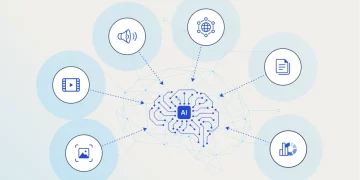Introduction:
Machine learning (ML) has become an essential tool in solving complex problems across various industries, from healthcare to finance and beyond. For data scientists, choosing the right machine learning framework is crucial to the success of a project. With numerous options available, each framework offering its own set of features, strengths, and trade-offs, how does one select the most suitable one for their needs?
In this article, we will explore the key factors data scientists need to consider when choosing a machine learning framework. These factors include ease of use, scalability, flexibility, community support, performance, and specific use cases. We will also compare some of the most popular frameworks such as TensorFlow, PyTorch, Scikit-learn, Keras, and XGBoost, among others, to help data scientists make an informed decision based on their project requirements.
1. Understanding Machine Learning Frameworks
A machine learning framework is a software library that provides tools, APIs, and predefined algorithms to help developers build machine learning models. These frameworks simplify the process of designing, training, and testing machine learning models, enabling data scientists to focus on solving business problems instead of dealing with low-level details of model development.
There are two broad categories of machine learning frameworks:
- Low-Level Frameworks: These provide more control over the model-building process, offering greater flexibility but requiring a deeper understanding of the algorithms and underlying concepts. Examples include TensorFlow and PyTorch.
- High-Level Frameworks: These are designed to be user-friendly and abstract away many of the complexities. They offer predefined models and workflows for faster development, such as Keras and Scikit-learn.
2. Factors to Consider When Choosing a Machine Learning Framework
2.1. Ease of Use
The complexity of a framework can significantly impact how quickly a data scientist can get started with building models. Some frameworks are easier to use, with user-friendly APIs, while others provide more control but require a deeper understanding of machine learning concepts.
- Beginner-Friendly: If you’re new to machine learning or don’t want to spend too much time configuring the framework, high-level libraries like Keras or Scikit-learn are excellent choices. These frameworks provide easy-to-understand APIs, extensive documentation, and pre-configured models that can be used right out of the box.
- Advanced Use Cases: If you’re tackling complex problems that require fine-tuned control, you might opt for TensorFlow or PyTorch. Both offer flexibility and control over the inner workings of the model, but they have a steeper learning curve compared to high-level libraries.
2.2. Flexibility and Customization
While beginner-friendly frameworks are ideal for fast prototyping and common machine learning tasks, they may lack the flexibility required for more complex or custom solutions. Data scientists who need to build custom models or work with cutting-edge research might need more flexibility.
- TensorFlow and PyTorch are highly flexible frameworks that allow deep customization of machine learning models. With these frameworks, data scientists can modify every aspect of the model and implement advanced techniques such as reinforcement learning or generative models.
- Scikit-learn is excellent for traditional machine learning models but may not be suitable for deep learning tasks, where flexibility is more critical. It provides a wide range of algorithms but doesn’t support neural networks as robustly as TensorFlow or PyTorch.
2.3. Scalability
Scalability refers to how well a framework can handle large datasets, train large models, and perform efficiently on different hardware setups. This is especially important when working with big data or real-time applications.
- TensorFlow and PyTorch both support distributed training, allowing models to be scaled across multiple machines or GPUs. These frameworks are optimized for parallel processing, making them suitable for training complex models on large datasets.
- XGBoost, a powerful gradient boosting framework, is well-suited for large-scale structured data problems. It is highly efficient in terms of memory and speed, making it a great option for competition-driven data science tasks such as Kaggle challenges.
- Scikit-learn is better suited for smaller datasets, as it doesn’t provide native support for distributed computing, which can limit scalability in more demanding tasks.
2.4. Community Support and Documentation
A strong community and excellent documentation can make a huge difference in how quickly a data scientist can learn and implement a framework. A large user base ensures regular updates, bug fixes, and the availability of tutorials and resources to solve common issues.
- TensorFlow and PyTorch both have large, active communities and extensive documentation. TensorFlow, in particular, is widely used in industry, with a wealth of tutorials, blog posts, and academic papers to learn from.
- Keras, now integrated into TensorFlow, also benefits from its community and resources, making it an excellent choice for data scientists who need a simple interface to access TensorFlow’s power.
- Scikit-learn has an active community in the academic and research sectors and is well-documented. However, since it’s primarily geared toward traditional machine learning, the community is more focused on models like decision trees, random forests, and support vector machines.
2.5. Performance
Performance refers to how well a framework optimizes resource usage, such as CPU/GPU utilization, training speed, and memory management. For large-scale models, the choice of framework can significantly impact performance.
- TensorFlow and PyTorch are optimized for performance on both CPUs and GPUs, making them ideal for deep learning and large-scale applications. PyTorch’s dynamic computation graph also helps improve debugging and efficiency in training deep learning models.
- XGBoost is designed for high-performance on large tabular datasets. It is known for its speed and accuracy in training boosting algorithms.
- Scikit-learn is not optimized for deep learning or large-scale training tasks. While it performs well with traditional models, it can be less efficient when handling big data or complex neural networks.
2.6. Use Case and Task Type
Certain frameworks are more suited to specific types of machine learning tasks. For example, deep learning models require different tools compared to classical machine learning models.
- Deep Learning: If your project requires deep learning (e.g., neural networks, convolutional neural networks, and recurrent neural networks), then TensorFlow and PyTorch are the best options. They both support a wide range of deep learning architectures and are highly optimized for such tasks.
- Traditional Machine Learning: If you’re working with classical machine learning algorithms such as regression, clustering, or decision trees, Scikit-learn is an excellent option. It provides a simple interface for model training, testing, and evaluation.
- Ensemble Learning: For boosting, bagging, and other ensemble methods, XGBoost is one of the most powerful libraries, especially for structured/tabular data.

3. Popular Machine Learning Frameworks Compared
3.1. TensorFlow
- Strengths: Highly flexible, large community, supports deep learning and distributed computing.
- Weaknesses: Steeper learning curve, less intuitive for beginners compared to Keras.
3.2. PyTorch
- Strengths: Dynamic computational graph, strong support for research, flexibility, and ease of use.
- Weaknesses: Can be slower for production deployments compared to TensorFlow, although this gap is closing.
3.3. Keras
- Strengths: High-level interface for TensorFlow, user-friendly, fast prototyping.
- Weaknesses: Less control over lower-level aspects of the model, primarily suited for deep learning.
3.4. Scikit-learn
- Strengths: Excellent for traditional machine learning tasks, easy to use, strong documentation.
- Weaknesses: Limited support for deep learning, less scalability for large datasets.
3.5. XGBoost
- Strengths: Exceptional performance with tabular data, fast training, and high accuracy.
- Weaknesses: Not as versatile for deep learning tasks.
4. How to Choose the Right Framework for Your Project
- For Deep Learning: If you need to build neural networks or work on large-scale image or language tasks, TensorFlow or PyTorch are your best options.
- For Classical Machine Learning: If you’re working with structured data, Scikit-learn or XGBoost will offer the necessary tools to build high-performance models.
- For Fast Prototyping: Keras (as part of TensorFlow) is ideal for quick and easy model building, especially if you’re primarily focused on deep learning tasks.
Questions to ask yourself:
- What type of machine learning tasks am I working on? (Deep learning vs classical machine learning)
- How important is ease of use? (Beginner vs advanced user)
- Do I need to scale my models? (Consider performance and scalability)
- How critical is community support? (Choose widely-used, well-supported frameworks)
5. Conclusion
Selecting the most suitable machine learning framework is an essential decision for any data scientist. The choice largely depends on the specific requirements of the project, including the type of machine learning tasks, the size of the dataset, the need for scalability, and the level of expertise available. TensorFlow and PyTorch dominate in the deep learning space, while Scikit-learn and XGBoost are excellent choices for traditional machine learning tasks. Keras offers a simplified interface for those looking to quickly prototype deep learning models. Ultimately, the right framework should align with both the technical needs of the project and the team’s expertise.











































